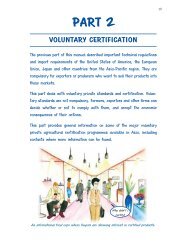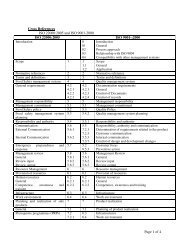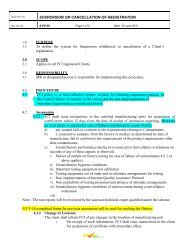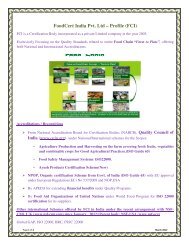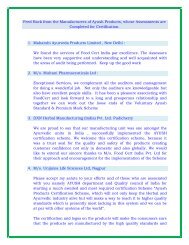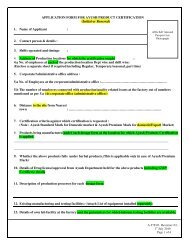Standard for Good Field Collection Practices - NMPB
Standard for Good Field Collection Practices - NMPB
Standard for Good Field Collection Practices - NMPB
Create successful ePaper yourself
Turn your PDF publications into a flip-book with our unique Google optimized e-Paper software.
ANNEX B<br />
GUIDELINES FOR COLLECTION AND POST-HARVEST MANAGEMENT OF<br />
VARIOUS CATEGORIES OF MEDICINAL PLANT PRODUCE<br />
The whole plant is used as a medicinal plant produce only in a few cases. Often it is one or more<br />
part like root, bark, stem, leaves, flowers, fruits, seeds of the species, which constitute the<br />
officially accepted produce. While the general guidelines <strong>for</strong> harvesting and post-harvest<br />
management are applicable to any collected part, the specific plant parts need additional care,<br />
Annex E.<br />
Ancient science, like Ayurveda, recommends collecting different parts of the plants in different<br />
seasons. This was perhaps done keeping in view the optimum activity of herbs when harvested<br />
at a specific season. Further, collecting the parts from the plant at a season when it causes the<br />
minimum harm to the plant is also important.<br />
It is recommended that a detailed SOP should be written <strong>for</strong> each category of produce in order to<br />
minimize the harm to nature and to optimize the quality of the produce. Some of the important<br />
points, which need to be taken care of while harvesting various categories, are given below.<br />
5.1. Underground parts<br />
6.1.1 The roots of annual plants must be dug when the plants are well developed and<br />
mature.<br />
6.1.2 Roots of perennials should be harvested late in the fall or early in the spring.<br />
Roots of biennial should be collected in either the fall of the first year or spring of<br />
the second year.<br />
6.1.3 The root material that is rich in essential oils should be handled carefully to<br />
prevent bruising of the epidermis, where the oils typically reside, which could<br />
result in loss of essential oil or its degradation.<br />
6.1.4 Unless otherwise required <strong>for</strong> any specific species, underground parts like roots<br />
and rhizomes should be collected only after the seed shedding. It also facilitates<br />
regeneration of species.<br />
6.1.5 Where taproot is the desired produce and needs to be uprooted, harm to other<br />
plant species in the vicinity should be minimized. Underground parts should be<br />
collected with minimum possible digging by using appropriate tools.<br />
6.1.6 When roots of species that are propagated vegetatively in nature are collected,<br />
enough underground part should be left at site to allow regeneration.<br />
6.1.7 It must be ensured that underground parts are thoroughly washed and thereafter<br />
dried to reduce the moisture content be<strong>for</strong>e packing the produce.<br />
Page 30 of 44



